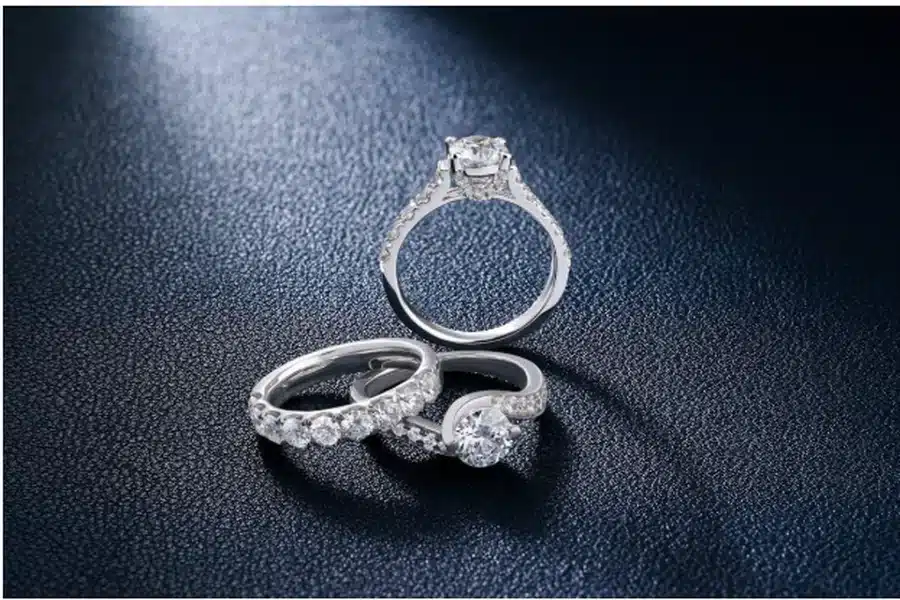Let’s get real—Moissanite Engagement Rings are all the rage right now. Perhaps you’ve seen them popping up on Pinterest boards, or maybe a friend or family member just got engaged and nonchalantly mentioned the word “Moissanite” in passing. If you found yourself nodding along while simultaneously Googling what it is, you’re not alone.
But even after you’ve got a handle on what Moissanite is (no, it’s not a “fake diamond”), there’s still a whole vortex of opinions, half-truths, and old myths swirling around it. So today, we’re giving you the real deal.
Let’s get to some of the most popular myths vs. realities about Moissanite Rings, and by the end, you might just rethink what “forever” should look like.
Myth #1: Moissanite Is Just a Cheap Diamond Imitation
Fact: Moissanite is its own beautiful gemstone.
Here’s the thing: Moissanite isn’t attempting to be a diamond. It’s a totally different gemstone with its own origin, properties, and brilliance.
Found in a meteor crater late in the 1800s by French scientist Henri Moissan (yep, that’s where the name originated)., natural moissanite is super rare. What you find in jewelry today is created in a lab, ethically made, and eco-friendly. So, if you thought it was merely a “knock-off” diamond, think again. Moissanite holds its own, and in many regards, it even surpasses diamonds. Literally.
Myth #2: It Looks Too Sparkly—It’s Clearly Fake
Fact: Moissanite’s fire and brilliance are part of its unique charm.
Ever seen that rainbow-like sparkle in Moissanite? That’s not a flaw; it’s referred to as fire, and Moissanite has more than diamonds.
In technical jargon, Moissanite measures higher on the refractive index (2.65–2.69) than diamonds (2.42). Translation? More sparkle. More shine. More light off the facets.
Now, this may not be the cup of tea for everyone. Some like the icy sparkle of diamonds, others adore the fiery shine of Moissanite. It’s all about what works for your style. So ask yourself: Would you prefer to go with what’s classic, or something that turns heads every time it sparkles?
Myth #3: Moissanite Will Get Cloudy Over Time
Fact: Moissanite doesn’t cloud; it remains clear and radiant.
There’s a common rumor going around that moissanite either fog clouds or yellows over time. Nope. Not true. That might occur with lower-cost cubic zirconia, but moissanite stays vibrant and stunning with age. It’s heat- and moisture-resistant, as well as resistant to most chemicals, which makes it a great daily-wear stone.
Yes, like any gem, it will get dirty with lotions, soap, or oils, but a soft clean returns it to its sparkling self.
Here’s a question: How frequently do you clean your engagement ring? If it’s less than monthly, it’s probably time for a little sparkle session, no matter the stone.
Myth #4: It’s Not “Sentimental” Enough Because It’s Not a Diamond
Fact: Sentiment comes from the story, not the stone.
Let’s break this down. Many people still think of diamonds as the symbol of eternal love, thanks to decades of advertising (shoutout to De Beers). But does love have to have a certain stone in order to be real?
What a ring means isn’t what it’s constructed of; it’s why you selected it. Perhaps you chose Moissanite because you wished to be ethical. Perhaps you and your partner preferred to save for a house rather than blow money on a ring. Perhaps you simply adored the way it looked.
There’s nothing less romantic about that. Actually, some would say it’s even more romantic when a ring aligns with your values. Myth #5: Moissanite Isn’t Durable for a Lifetime
Fact: Moissanite is one of the hardest gemstones available.
Believe diamonds are the only gemstones hard enough for everyday wear? Think again. Moissanite rates 9.25 on the Mohs hardness scale, just shy of diamonds (which rate a 10). That makes it extremely resistant to scratching, chipping, or breaking.
Want to put it to the test? Try wearing a Moissanite ring for a year and notice how many compliments you receive compared to how often it gets scratched. Spoiler alert: You’ll likely get so many compliments that you lose track before you ever notice a single scratch.
Why the Mixed Opinions?
Let’s get real: part of the negativity surrounding Moissanite Engagement Rings is a matter of outmoded concepts regarding tradition and worth. There’s this still-persistent myth that if it’s not a diamond, then it’s not good enough for an engagement. But couples nowadays are better-educated, more mindful, and more open to upending old norms.
Whether it’s sustainability, price, or just plain looks, people are setting their own rules, and Moissanite perfectly slots into that frame of mind.
A Final Thought
Before you settle on any ring—diamond, moissanite, or otherwise—ask yourself: What’s more important to me: *looks or tradition? Sparkle or narrative? Cost or personal significance?*
Regardless of your response, ensure you’re picking a ring that speaks to your love story, not someone else’s vision of what love is.
And if you’re interested in seeing more designs or even thinking about a Moissanite ring, take a look at Rosec Jewels. It offers a carefully curated selection of stunning, high-quality Moissanite Engagement Rings that don’t sacrifice brilliance, sentiment, or style.
Because ultimately, the truth is this: love isn’t about the stone, it’s about the sparkle it brings to your life.




